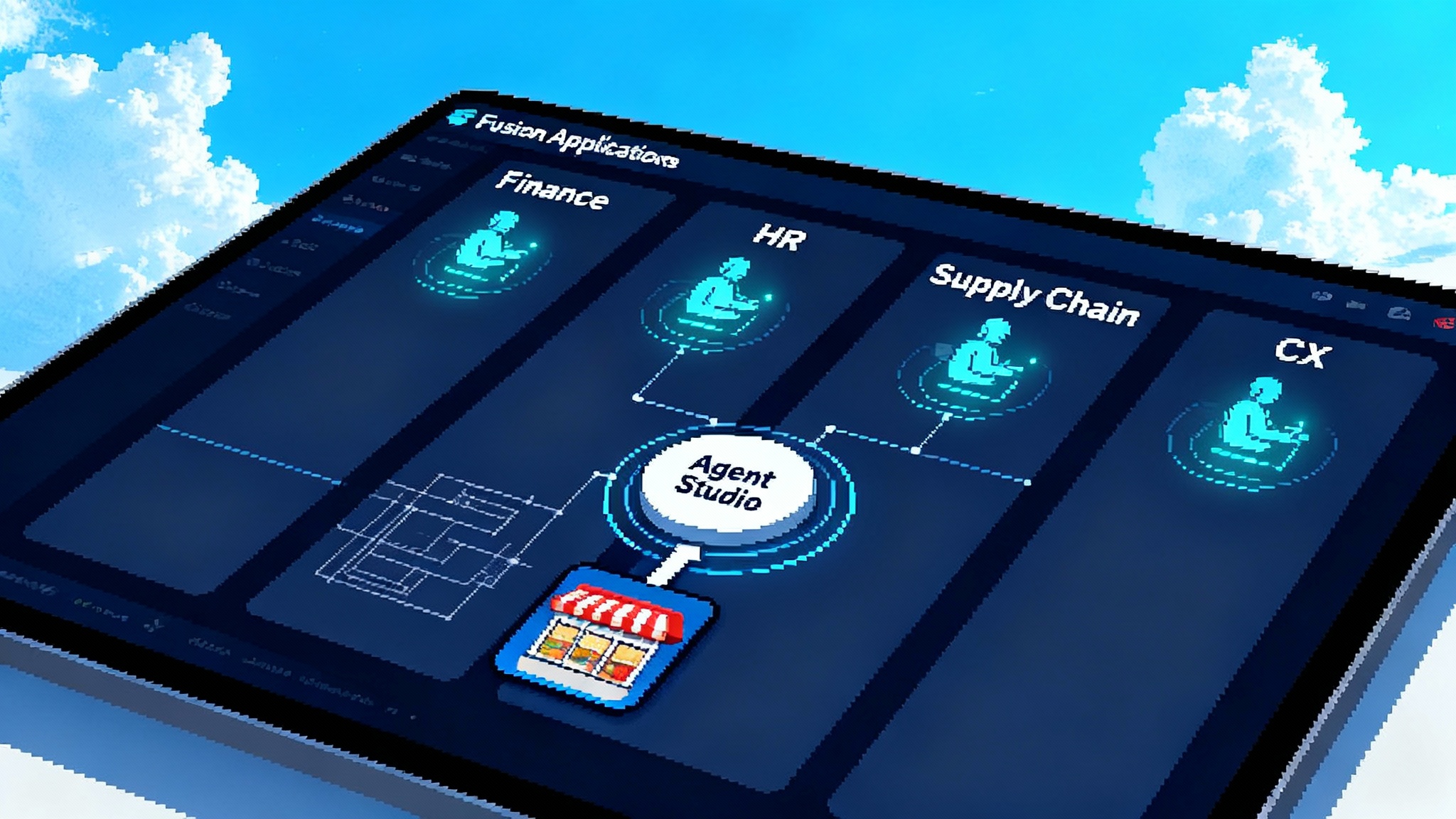Oracle’s Fusion AI Agents Go Live With a Marketplace
At Oracle AI World on October 15 to 16, 2025, Oracle embedded task ready AI agents across Fusion ERP, HCM, SCM, and CX and introduced Agent Studio with a built in marketplace. Here is the architecture, tradeoffs, and a CIO playbook to capture ROI.

Breaking: Oracle pushes agents from pilots to production
On October 15 to 16, 2025 in Las Vegas, Oracle moved AI agents from talk track to tool belt. The company embedded task ready agents across Fusion Applications and expanded its Agent Studio with a native marketplace so enterprises can deploy partner built agents inside the same workflows finance, HR, supply chain, and customer teams use every day. The announcement was part of Oracle AI World and included details on new controls, evaluation tools, and support for open standards. For the official rundown, see Oracle’s press release on the Agent Studio update and marketplace launch.
This is not another chat window stapled on top of business software. Oracle is making a bet on embedded, domain specific agents that act on transactions, respect policies, and leave an audit trail.
What actually launched
Oracle delivered three pillars that matter for regulated enterprises:
- Embedded agents in Fusion ERP, HCM, SCM, and CX that execute specific tasks like payables intake, fulfillment processing, sales order assistance, and talent planning.
- Agent Studio, a build and lifecycle environment where teams design, test, approve, version, and monitor agents that run inside Fusion workflows.
- A native Agent Marketplace, surfaced within Fusion Applications, that offers Oracle validated partner agents alongside Oracle’s own and installs them into the same control plane.
Together, these pillars move agents beyond pilots by putting them where the work happens and by giving enterprise owners the levers they require: identity, policies, approvals, and observability.
The architecture in plain English
Think of Fusion as a set of busy highways. Oracle’s agents are not side roads. They are lane assist systems built into the road itself. Drivers still steer, but the lanes now suggest, correct, and sometimes drive within guardrails. Here are the parts that make this work.
1) Embedded controls in Fusion
- Role aware actions. Agents inherit Fusion roles, so a Payables Agent cannot create a supplier if the user’s role would not allow it.
- Policies and approvals. Agents route transactions through the same approval chains finance and HR already configured. Human in the loop steps are first class, not an afterthought.
- Deterministic workflows. For critical processes, builders can set prescriptive paths where each step is defined, tested, and auditable. This limits surprises during periods such as month end close.
2) Agent Studio and the marketplace
- Studio. Build, test, evaluate, and publish agents. Manage prompts centrally, store credentials safely, and version topics and templates. The platform supports multiple large language models so teams can pick models by task and cost profile.
- Marketplace. Partner agents install directly into Fusion. They appear in the same menus, use the same identities and controls, and share the same telemetry. This reduces the integration grind and the compliance anxiety that would come with external bots.
3) Standards that connect the stack
- Model Context Protocol (MCP). MCP lets agents connect to external tools and data using a common interface. Instead of custom adapters for every system, builders can add MCP servers that expose actions like get order, update case, or retrieve document. Studio’s MCP support makes those actions available to agents with consistent security and logging.
- Agent to Agent (A2A). A2A enables cross agent handoffs. An order triage agent can pass a structured card to a fulfillment agent with context, constraints, and a trace of what happened. This gives you composition without a brittle web of one off calls.
4) Observability and evaluation
- Tracing and metrics. Session counts, latency, error codes, and token usage are visible. That makes cost and reliability measurable.
- Scenario tests. Teams can define what good looks like and measure agents against accuracy, safety, and compliance scores before rollouts.
- Prompt libraries. Instead of prompt sprawl in documents, there is a managed store with version control so every change is reviewable.
Why this differs from a generic copilot
Generic copilots are helpful for drafting and summarization. They excel when the task is typing and the output is text. Enterprise process work is different. It is about changing systems of record, collecting approvals, enforcing segregation of duties, and closing the loop when real money moves.
Oracle’s approach has three structural advantages for that kind of work:
-
Direct access to context and actions. The agents sit inside Fusion. They read ledgers, orders, and employee data with the same permissions users have. They can write updates, not just suggest prose. That shortens the distance between recommendation and resolution.
-
Determinism where it matters. Finance and supply chain teams want predictable workflows. Agent Studio allows builders to chain deterministic nodes for steps like three way match or payment release, then bring an adaptive agent back in when judgment is required, such as interpreting a vendor email.
-
Built in governance. Identity, approvals, and audit trails are native. You do not need to bolt on a separate control system to get signoffs or evidence for auditors.
Concrete use cases across ERP, HCM, SCM, and CX
Below are examples that illustrate why embedded agents are different from chat assistants.
Payables intake and straight through processing
- What the agent does. Pulls invoices from email and supplier portals, normalizes formats, matches to purchase orders and receipts, applies tax and policy checks, and submits for approval. If all checks pass, it schedules payment. If not, it explains the exception and proposes a fix.
- Why it matters. Accounts payable teams spend hours on data entry and exception chases. An embedded agent can push straight through rates up by automating routine invoices and reducing avoidable mismatches.
- How to pilot. Choose two supplier categories, one variable expense and one recurring service. Measure cycle time, exception rate, and early pay discounts captured before and after.
Planning that does not wait for month end
- What the agent does. Monitors actuals and drivers during the month, flags anomalies, and runs what if analyses when signals change. It can guide planners through scenarios like a 2 percent supplier price increase or a sudden drop in bookings.
- Why it matters. Forecasts drift between cycles. Near real time analysis can cut surprises and reduce manual workbook gymnastics.
- How to pilot. Pick three volatile cost drivers. Lock simple decision rules, such as when to refresh a forecast, and instrument impact on forecast error and cycle time.
Fulfillment under pressure
- What the agent does. Retrieves order status, initiates picking, recommends packing, and executes shipping for urgent orders. It resolves common blockers, like a missing customer preference or an inventory discrepancy, by checking available stock and offering alternatives.
- Why it matters. Hot orders consume manager time and create queues. An embedded agent can unblock many without a war room.
- How to pilot. Target a single region with high expedite rates. Track perfect order rate, expedite cost per order, and backlog days.
HR moments that managers actually use
- What the agent does. Prepares one on one summaries from goals, performance notes, and feedback. Suggests follow ups and pulls compensation and leave context when managers ask.
- Why it matters. Managers struggle to assemble all the context for each conversation. The agent makes the prep step a two minute task rather than thirty.
- How to pilot. Run with one function and a cadre of willing managers. Measure manager satisfaction, skipped one on ones, and time saved.
Sales and service with fewer handoffs
- What the agent does. Surfaces deal guidance from approved content, drafts replies to service tickets, and warns when a case is likely to escalate so supervisors can intervene early.
- Why it matters. The best guidance is the guidance reps actually see while they work. Agents embedded in the console remove context switches.
- How to pilot. Use a single product line. Track first contact resolution, time to first response, and attachment of approved references in deals.
Partner momentum inside the marketplace
The marketplace strategy only works if partners show up. They have. IBM, for example, published new agents for sales order entry and intercompany workflows that are built with Oracle’s Agent Studio and install directly into Fusion environments. That signals a shift from slideware to shippable packages that comply with the same security and approval model as Oracle’s own agents. See IBM’s announcement on new AI agents in Oracle’s marketplace.
For buyers, this means less custom integration and more plug and play options that still meet enterprise requirements. For partners, it means a distribution channel that reaches the Fusion installed base without inventing a parallel control stack.
How this compares to other agent platforms
Enterprises now have several credible approaches to agents. Oracle’s move lands in a landscape where vendors are converging on deeper control and embedded execution.
- If you want a blueprint for turning prototypes into governed products, study the patterns in governed, shippable agent patterns from [/agentkit-turns-ai-agents-into-governed-shippable-products]. Oracle’s Studio echoes many of those controls and lifecycle gates.
- If your estate leans on CRM, the Salesforce Agentforce 360 approach at [/salesforce-flips-the-switch-agentforce-360-turns-crm-into-agents] shows how another large platform is fusing agents directly into its application surface.
- If you operate at the network edge, Cloudflare’s work on Agents SDK at the edge in [/cloudflares-agents-sdk-turns-the-edge-into-runtime] highlights a different runtime philosophy that can complement back office agents with low latency, perimeter aware tasks.
These perspectives underline a broader trend: the winning designs put agents where the data, permissions, and controls already live, rather than asking users to copy paste context into a separate assistant.
A CIO playbook to capture ROI and stay in control
Here is a concrete, staged plan you can run in a regulated enterprise. It is designed for ninety days to first value, then a second wave of scale.
Week 0 to 2: Establish the control plane
- Name an Agent Owner for each domain, such as Payables, Fulfillment, and Talent. A Director level leader is ideal.
- Stand up a non production Fusion pod tied to Studio. Turn on observability, set token budgets, and integrate your identity provider.
- Create an agent registry. Include purpose, inputs, outputs, roles, approval gates, and logging requirements for every agent.
Week 2 to 6: Run two to three narrow pilots
- Payables. Start with invoice categories that already exhibit high match rates.
- Planning. Target a volatile cost driver with a bounded scenario, such as fuel or third party logistics.
- Fulfillment. Focus on high priority orders in one region and one distribution center.
- For each pilot, define three key metrics tied to money and risk. Examples: straight through rate, forecast error, perfect order percentage, rework rate, and number of approvals bypassed. Baseline them.
Week 6 to 9: Harden for scale
-
Turn deterministic nodes on for critical steps. For example, always require a configured three way match before payment release.
-
Wire in human in the loop review where policy or judgment is required. Define an explicit timeout rule that escalates to a role, not a person.
-
Add A2A handoffs between agents. For instance, when the Payables Agent flags a pricing discrepancy, pass a structured card to a Purchasing Agent with supplier, item, and price history.
-
Use MCP to connect one external system safely. Start with a low risk tool such as a document repository so you can exercise credentials and audit paths.
Week 9 to 12: Production with guardrails
- Promote agents to production behind feature flags and canary groups. Start with a 10 percent user cohort and ramp only when metrics improve.
- Publish dashboards to finance and operations leaders that show throughput, exceptions, and savings. Do not bury token usage. Make cost per task visible.
- Hold a change review for prompts and templates every week. Treat prompts like code, with approvals and rollbacks.
How to compute value without hand waving
- Straight through processing. Value equals invoices processed automatically multiplied by minutes saved per invoice multiplied by fully loaded cost per minute. Include exception reduction, not just throughput.
- Forecast stability. Value equals reduction in forecast error multiplied by variance cost per unit. Tie it to fewer expedite shipments or avoided inventory build.
- Perfect orders. Value equals reduction in late or incomplete orders multiplied by penalty and goodwill costs. Add the working capital impact of faster invoicing.
Risk, governance, and what to ask your auditors
- Identity and segregation of duties. Ensure agents use service identities that inherit least privilege roles. Prohibit shared credentials. Inventory every API key in a credential store.
- Evidence and auditability. Log who initiated an agent session, what data it read or wrote, and which approvals were applied. Keep a hash of prompts and model versions for each transaction.
- Safety and fallback. Define hard stops for actions like vendor creation or payment release when confidence scores drop or controls fail. Require a human approval path with a clear timeout.
- Model choice and cost. For deterministic steps, favor cheaper models or no model at all. Reserve premium models for interpretation tasks where quality gains translate to money or risk reduction.
- Change management. Treat prompts, topics, and templates as governed artifacts. Require peer review. Keep a test suite that covers your top exception types.
Questions to take into your next steering meeting:
- Which three processes create the most rework, and which of those have clear rules we can encode as deterministic nodes?
- What is the minimum evidence our auditors will accept for agent led payments and supplier changes?
- Where can MCP give us a safe connector to a system we currently integrate with brittle custom code?
- Which partner agents in the marketplace overlap with our backlog, and what would it cost to buy rather than build?
Buy, build, or partner
- Buy when the agent is a standard pattern, like intercompany agreement review or sales order entry. Marketplace packages will install faster and bring support agreements.
- Build when the workflow is unique to your business and the value is strategic. Studio’s deterministic chaining and human in the loop make bespoke processes tractable.
- Partner when you have a transformation on a tight timeline. A partner that ships agents you can install in the marketplace will cut integration risk and lift your capacity to manage change.
What this means for the enterprise software race
Oracle is leaning into a simple idea that is hard to execute: put agents where work and controls already live. By embedding agents in Fusion, adding a studio that speaks enterprise, and shipping a marketplace that partners can fill, Oracle makes agents feel like part of the application rather than a bot on the side. The standard hooks, from MCP to A2A handoffs, reduce custom plumbing and make it possible to compose cross function workflows that still pass audits.
The next twelve months will decide whether embedded agents become the default way to operate core systems. If you run Fusion, you do not need a lab to find out. Start with payables, planning, and fulfillment. Use the control plane you already own. Prove the numbers. Then scale the agents that earn their keep.
That is how pilots turn into production and how automation finally sticks.








